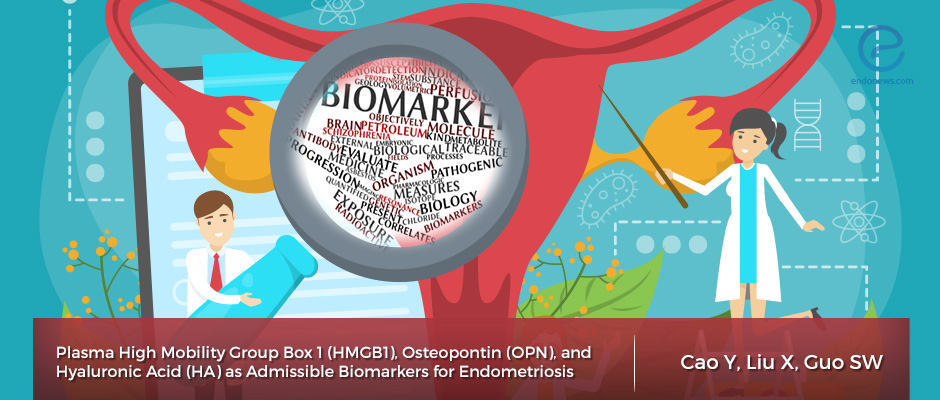Plausible biomarkers for noninvasive endometriosis diagnosis
Aug 9, 2019
Plasma High Mobility Group Box 1 (HMGB1), Osteopontin (OPN), and Hyaluronic Acid (HA) are promising biomarkers for noninvasive diagnosis of endometriosis
Key Points
Highlight:
- Dr. Guo group provide new insight that plasma High Mobility Group Box 1 (HMGB1), Osteopontin (OPN), and Hyaluronic Acid (HA) are promising admissible biomarkers for endometriosis.
Background:
- A non-invasive diagnostic procedure does not exist for endometriosis, until now; mainly due to the heterogeneity in location, size, depth of infiltration,...
- Accumulating studies show that fibrosis occurs in endometriotic tissues which are repeatedly injured and healed.
- A genuine peripheral biomarker for endometriosis should able to reflect the dynamic change including fibrosis in endometriosis.
- Here, Dr. Guo group from Fudan University in China decided to identify biomarkers using a mouse and human tissues with endometriosis.
Key points:
- The level of HMGB1 and OPN in the mouse plasma is significantly higher in mice with endometriosis compared to the control group.
- Those candidates were tested in both endometriotic lesion and fibrosis by performing immunohistochemistry.
- From the multiple linear regression analysis including HMGB1, OPN, and HA, only OPN was associated with the extent of fibrosis.
- However, all three putative markers were associated with the endometriosis lesion weight, but the plasma OPN levels had the highest correlation.
- In human, the level of plasma HMGB1, OPN, and HA in women with endometriosis were significantly higher than the level in healthy control.
- The markers are also positively correlated with the extent of lesional fibrosis
Conclusions:
- Plasma HMGB1, OPN, and HA levels are all admissible biomarkers for endometriosis from both mouse and human endometriosis tissues.
- However, this study only has limited samples so the finding requires to be confirmed in a large sample group with different subtypes of endometriosis.
Lay Summary
Endometriosis is an estrogen-dependent benign gynecological disease characterizing ectopic deposition of endometrial tissue outside of the uterine cavity. It affects about 10% of reproductive-aged women and causes enormous negative impacts on the quality of lives. However, we do not have a non-invasive diagnostic procedure until now. Furthermore, there is no single published biomarker which was clinically validated. According to the previous study, the ideal biomarker is the one which is specific to the disorder, can be detected early in the disease process, accessible from peripheral tissue (non-invasive), stable, reproducible, and associated with a known mechanism. The main reason that we do not have a biomarker in endometriosis is the vast heterogeneity in location, size, color, depth of infiltration, presence or absence of adhesion, and comorbidity. Accumulating studies show that fibrosis happens in endometriotic tissues where are repeatedly injured and healed. Therefore, a genuine peripheral biomarker for endometriosis should able to reflect this dynamic change including fibrosis in endometriosis.
Here, Dr. Guo group from Fudan University in China decided to identify biomarkers using a mouse model of endometriosis. Then evaluated the set of putative markers in human endometriosis. This study has been recently published in the journal of Scientific Reports.
First, they measured the plasma concentrations of HMGB1, OPN, and HA in control and endometriosis mice model. The level of HMGB1 and OPN is significantly higher in mice with endometriosis compared to the control group. Those candidates were tested in both endometriotic lesion and fibrosis by performing immunohistochemistry. They wondered if the level of those markers in serum correlates with the extent of fibrosis. From the multiple linear regression analysis including HMGB1, OPN, and HA, only OPN was associated. However, all three putative markers were associated with the endometriosis lesion weight, but the plasma OPN levels had the highest correlation.
The authors confirmed the result that they found with a mouse model with human endometriosis tissue. A total of 30 patients with ovarian endometrioma and 20 healthy people participated. The level of plasma HMGB1, OPN, and HA in women with endometriosis were significantly higher than the level in healthy control. Interestingly, this level was much lower three months after the patients have lesional-removal surgery. The markers are also positively correlated with the extent of lesional fibrosis.
In conclusion, from both mouse and human endometriosis tissues, plasma HMGB1, OPN, and HA levels are all admissible biomarkers for endometriosis. However, there are several limitations. This study only has limited samples so the finding requires to be confirmed in a large sample group. Also, this study could not investigate the different subtypes of endometriosis. Furthermore, this study could not evaluate the symptomology, stage, co-morbidity, age, and other potential confounding factors.
Research Source: https://www.ncbi.nlm.nih.gov/pubmed/31239500
High Mobility Group Box 1 Osteopontin Hyaluronic Acid Biomarkers Endometriosis

